
BLE Beacons: The Warehouse Navigators
September 06, 2024
 In the vast and bustling environments of warehouses, where efficiency is paramount and every second counts, BLE Beacons (Bluetooth Low Energy Beacons) have emerged as the navigators of the modern logistics era. These beacons are not just technological tools; they are the compasses guiding the way to a more organized, responsive, and intelligent warehouse management system.
In the vast and bustling environments of warehouses, where efficiency is paramount and every second counts, BLE Beacons (Bluetooth Low Energy Beacons) have emerged as the navigators of the modern logistics era. These beacons are not just technological tools; they are the compasses guiding the way to a more organized, responsive, and intelligent warehouse management system.
The Beacons of Warehouse Innovation
BLE Beacons are small, wireless devices that use Bluetooth technology to communicate with nearby devices. In the context of warehouse operations, they serve as the eyes and ears of the inventory, providing real-time data and insights that can revolutionize the way goods are managed and tracked.
Enhancing Inventory Visibility and Accuracy
One of the primary challenges in warehouse management is maintaining accurate inventory records. BLE Beacons, when attached to goods or installed at strategic locations, can provide real-time tracking of items, ensuring that inventory levels are always up-to-date and discrepancies are minimized.
Optimizing Warehouse Layout and Operations
The layout of a warehouse can significantly impact operational efficiency. By using BLE Beacons to monitor the movement of goods and personnel, managers can analyze traffic patterns and optimize the warehouse layout to reduce bottlenecks and improve workflow.
Automating Asset Tracking and Management
Managing a large number of assets in a warehouse can be a complex task. BLE Beacons can automate this process by providing real-time location data, allowing for more efficient use of assets and reducing downtime. This can lead to cost savings and improved service levels.
Improving Safety and Security
Safety is a critical concern in warehouse environments. BLE Beacons can be used to create geofenced zones around hazardous areas, sending alerts to workers when they enter these zones. Additionally, beacons can be integrated with security systems to monitor access to restricted areas, enhancing overall warehouse security.
Applications of BLE Beacons in Warehouse Management
The applications of BLE Beacons in warehouse management are numerous and diverse:
- Inventory Tracking: Track the movement and location of inventory items in real-time, reducing the time spent on manual counting and improving accuracy.
- Efficient Goods Allocation: Guide workers to the correct items for order fulfillment, reducing the time spent searching and the risk of picking errors.
- Maintenance Scheduling: Monitor the usage and condition of equipment to schedule maintenance proactively, reducing downtime and extending the life of assets.
- Worker Safety: Set up safety zones and send alerts to workers in case of potential hazards, ensuring a safer working environment.
The Future of BLE Beacons in Warehouse Management
As technology continues to evolve, the capabilities of BLE Beacons are expected to grow. With advancements in AI and machine learning, beacons could offer predictive analytics, automated inventory management, and a more personalized warehouse experience.
Privacy and Data Security
With the rise of BLE Beacons, privacy and data security become paramount. Warehouse operators must ensure that the use of beacons complies with data protection regulations and that sensitive inventory data is handled securely and transparently.
Conclusion
BLE Beacons are the beacons of innovation in warehouse management, offering a beacon of hope for a more efficient, organized, and intelligent approach to managing inventory and assets. As the industry continues to embrace smart technology, BLE Beacons will play an increasingly vital role in shaping the future of warehouse operations.
Leave a Reply
Related Products
You Might Like Also

In the realm of wireless communication, Bluetooth advertising has carved out a niche for itself, becoming an indispensable technology for short-range connectivity. At the heart of Bluetooth functionality lies the advertising process, which is the cornerstone for device discoverability and connection establishment. This article delves into the intri Read More

Bluetooth data structures are the foundational elements that govern how data is packaged, transmitted, and received within the Bluetooth ecosystem. These structures are designed to optimize the efficiency and reliability of wireless communication, ensuring that data is handled effectively across various devices and platforms. Read More

In the intricate world of wireless communication, Bluetooth Protocol Stack has established itself as a cornerstone technology, facilitating seamless connectivity between a plethora of devices. At the heart of this technology lies the Bluetooth protocol stack, a structured set of protocols that govern how devices communicate. One of the most critica Read More

In the intricate world of wireless communication, the Bluetooth Generic Access Profile (Bluetooth GAP) of Bluetooth technology stands as a cornerstone, enabling devices to connect, communicate, and collaborate seamlessly. This article delves into the essence of Bluetooth GAP, its role in establishing connections, and the myriad ways it enhances our Read More

The Data Transport Architecture in BLE is designed to accommodate the needs of low-power, low-data rate applications while maintaining high reliability. It operates on a connection-oriented basis, where devices establish a connection before data exchange commences. This architecture is composed of several key elements, including the Logical Link Co Read More

The Physical Layer is the foundation of any wireless communication protocol, including Bluetooth LE. It defines the basic parameters for the transmission of raw data bits over the air. In the context of BLE, the PHY is responsible for modulating the data onto a carrier signal, transmitting it through the antenna, and then demodulating the received Read More











